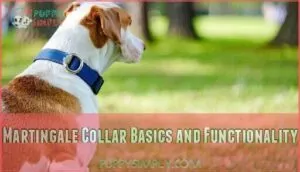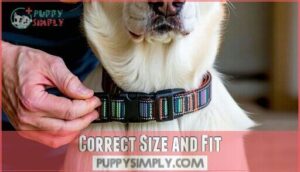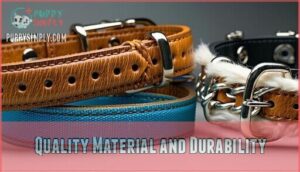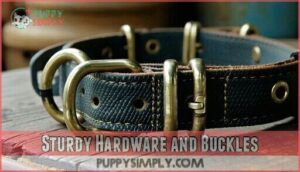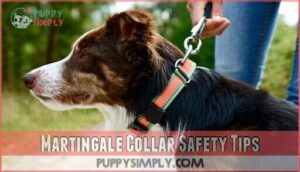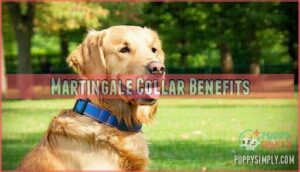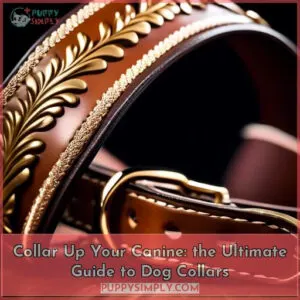This site is supported by our readers. We may earn a commission, at no cost to you, if you purchase through links.
 Martingale collars are a smart tool for dog owners looking to balance safety and control.
Martingale collars are a smart tool for dog owners looking to balance safety and control.
They are designed with two loops, they tighten gently when your dog pulls, preventing escape without choking or causing discomfort.
These collars are especially useful for dogs with narrow heads, like Greyhounds, or those prone to slipping out of traditional collars.
To get the best fit, measure your dog’s neck snugly and choose a collar with some adjustability.
They’re great for training, everyday walks, or unruly pups learning leash manners, and want a collar that’s comfortable, durable, and stylish, there’s more to explore in finding the perfect martingale collar.
Table Of Contents
- Key Takeaways
- What is Martingale Collar
- Choosing Right Martingale Collar
- Top 13 Martingale Collars
- 1. Pink Nylon Martingale Collar Donate
- 2. Heavy Duty Martingale Dog Collar
- 3. Martingale Dog Collar Large Blueberry
- 4. Personalized Dog Collar with ID
- 5. Burgundy Sheepskin Leather Dog Collar
- 6. Trainer Approved Martingale Dog Collar
- 7. ComfortFlex Martingale Dog Collar
- 8. Reflective Dog Collar with Quick Release Buckle
- 9. PetSafe Martingale Collar for Dogs
- 10. Dazzber Martingale Collar for Large Dogs
- 11. Country Brook Pink Martingale Collar
- 12. Ruffwear Web Reaction Martingale Collar
- 13. Max and Neo Purple Martingale Collar
- Martingale Collar Safety Tips
- Martingale Collar Benefits
- Frequently Asked Questions (FAQs)
- Do vets recommend martingale collars?
- Are martingale collars good for training dogs?
- Is it OK for a dog to wear a martingale collar all the time?
- What does a martingale collar do?
- Do martingale collars stop pulling?
- Are martingale collars ethical?
- Are martingale collars suitable for puppies?
- Is it safe to leave a martingale collar on my dog when unsupervised?
- How often should I check the fit of my dog’s martingale collar?
- When should I transition my dog to a martingale collar?
- Conclusion
Key Takeaways
- Martingale collars gently tighten when your dog pulls, offering control without choking and preventing escapes.
- They’re ideal for narrow-headed breeds or dogs prone to slipping out of traditional collars.
- Always supervise your dog while using a martingale collar and ensure a proper fit with the two-finger rule.
- These collars are great for training, leash manners, and everyday walks, combining safety, comfort, and durability.
What is Martingale Collar
A martingale collar is a type of dog collar designed to prevent your pup from slipping out while staying safe and comfortable.
It gently tightens when your dog pulls, giving you better control without causing harm.
Martingale Collar Basics and Functionality
Martingale collars, also called limited slip collars, are no-slip design dog training collars offering a humane alternative to choke chains.
They tighten gently, preventing escapes while ensuring a comfortable fit. Their thoughtful design avoids choking, offering control instead of pain.
- Features two loops: Tightens when the dog pulls.
- Adjustable collar tightening: Limits pressure for safety.
- Ideal for leash attachment: Adds reliability during walks.
These collars are especially useful for breeds needing escape-proof dog collars.
How Martingale Collars Work
Imagine walking your dog confidently, knowing their collar won’t slip off.
Walk your dog with confidence and ease, knowing their secure collar ensures safety and comfort on every adventure.
That’s the magic of limited slip collars. They use two loops: one around your dog’s neck and a smaller one for leash attachment.
When leash tension builds, the gentle tightening keeps the collar snug but safe. This no-choke design guarantees humane dog training, blending control with comfort.
Benefits of Using a Martingale Collar
Using a martingale collar offers multiple benefits for dogs and owners.
A martingale collar ensures safe, gentle control while preventing escapes—perfect for training, leash manners, and secure, relaxed walks.
It’s a humane training aid designed for gentle correction and enhanced dog safety.
Perfect for sighthounds and narrow-headed breeds, these escape-proof collars improve leash manners while distributing pressure evenly.
- Reduces pulling gently
- Prevents escapes effectively
- Guarantees comfort and safety
- Suitable for breed-specific needs
- Promotes controlled, humane dog training
Choosing Right Martingale Collar
Picking the right martingale collar guarantees your dog stays safe, secure, and comfortable during walks.
Focus on proper sizing, durable materials, and thoughtful features like adjustability to meet your pet’s unique needs.
Correct Size and Fit
Getting the size right is key for martingale collars.
Measure snugly behind your dog’s ears, following these guidelines:
| Measuring Technique | Fit Check | Adjusting Frequency | Breed Considerations |
|---|---|---|---|
| Soft tape measure | Two-Finger Rule | Regularly for growth | Narrow heads like Greyhounds |
| Base of neck accuracy | Slight tension space | Weight changes | Avoid oversized collars |
| Match largest neck size | Avoid slipping out | Check monthly | Works for escape-prone breeds |
| Include adjusting space | No choking risk | Avoid extra looseness | Fit for comfort |
Proper collar fitting guarantees safety and control.
Selecting the right collar involves understanding martingale collar sizing.
Quality Material and Durability
Choosing the best martingale collar means picking materials that guarantee comfort and long-term use.
Nylon dog collars are lightweight and durable, while leather offers a classic look with strength.
Here are key tips:
- Nylon vs Leather: Decide based on your dog’s lifestyle.
- Chain Durability: Ideal for strong pullers.
- Fabric Softness: Prevents irritation.
- Stitching Quality: Reinforced seams matter.
- Longevity: High-quality materials last longer.
For dogs with sensitive skin, consider hypoallergenic collar materials.
Sturdy Hardware and Buckles
A martingale collar’s hardware and buckles must prioritize safety and durability. Look for sturdy buckle materials, robust chain strength, and rust resistance, guaranteeing the collar lasts under daily use.
Locking mechanisms enhance security, while reliable stitching boosts collar durability. For those seeking specific collar components, various options are available.
Avoid flimsy collar hardware or buckles, as they compromise the design’s purpose—control and safety in one package!
| Feature | Benefit | Why It Matters |
|---|---|---|
| Buckle Materials | Long-lasting use | Prevents breaking |
| Hardware Durability | Extra control | Ensures reliability |
| Chain Strength | Strength and safety | Handles strong pulls |
| Rust Resistance | Weatherproof design | Withstands elements |
Adjustability and Reflective Options
Adjustable dog collars, like martingale collars, offer flexible sizing for growing pups or weight changes, ensuring comfort and control.
Reflective options enhance safety during early morning or late-night walks.
Combine that with buckle security and sturdy materials, and you’ve got a collar that’s reliable and visible.
You can find a great martingale adjustable collar online.
With proper collar adjustment, your dog stays stylish and safe, even in dim lighting.
Top 13 Martingale Collars
Finding the right martingale collar guarantees your dog stays safe, comfortable, and stylish on every walk. Here are 13 top picks designed for durability, functionality, and your pup’s unique needs.
1. Pink Nylon Martingale Collar Donate
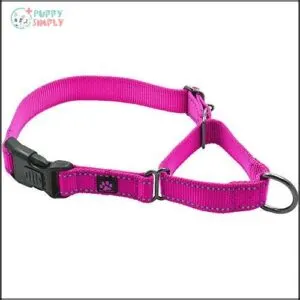
Sometimes, the best purchases do double duty, like the Pink Nylon Martingale Collar by Max and Neo.
This collar combines practicality and purpose with its durable 1-inch-wide nylon and lockable safety buckle. Reflective stitching guarantees you’re visible during nighttime walks, adding peace of mind.
Better yet, every purchase donates an identical collar to a dog rescue, so you’re helping dogs in need while keeping your own pup secure. Stylish, functional, and compassionate—a collar that truly makes a difference.
These collars are often used as training and safety tools, providing double duty as both training aids.
Best For: Dog owners who want a durable collar that supports rescues with every purchase.
- Durable nylon material with reflective stitching for better visibility
- Lockable safety buckle prevents accidental release
- Supports dog rescues through 1-for-1 donation program
- Limited color option (only available in pink for this product)
- Some frustration over size availability in certain colors
- Not all sizes are priced the same, with larger sizes costing more
2. Heavy Duty Martingale Dog Collar
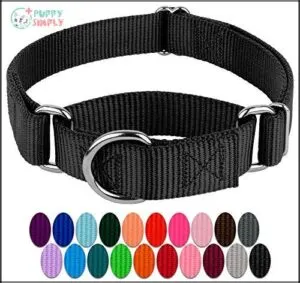
The Heavy Duty Martingale Dog Collar packs the strength and durability you need for energetic pullers.
Designed with tough nylon webbing and a powder-coated steel D-ring, it’s built to withstand over 800 pounds of force.
This collar tightens gently without choking, making it escape-proof yet safe for your pup.
Its adjustable fit suits medium to large breeds like Labradors or German Shepherds, and its sturdy design guarantees effective control during walks, helping your dog stay safe and secure.
Best For: Active medium to large dogs, including strong pullers, needing a secure and durable collar for training or walks.
- Durable nylon webbing and powder-coated steel D-ring withstand over 800 lbs of force.
- Adjustable fit ensures comfort and security for medium to large breeds.
- Gently tightens, making it escape-proof without choking.
- Lacks reflective properties for low-light visibility.
- Not suitable for tie-out or unsupervised use.
- Martingale loop may hit front legs during loose leash walking.
3. Martingale Dog Collar Large Blueberry
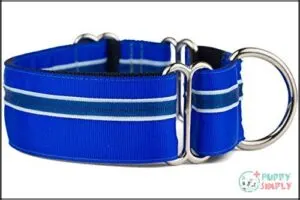
The Large Blueberry Martingale Dog Collar remarkably combines function and flair, offering control and style for active dogs.
It’s handmade in the USA, crafted from military-grade webbing, making it tough yet comfortable.
The no-buckle, slip-over design guarantees a secure fit, while the humane no-choke system gently tightens as needed.
It’s perfect for walking Boxers, Labradors, or other large breeds, and is adjustable and durable, keeping your pet stylish and safe, proving that practical doesn’t have to mean boring!
Best For: Owners of large dog breeds like Boxers or Labradors looking for a durable, stylish, and secure collar for safe walks or training.
- Durable military-grade webbing ensures long-lasting use.
- Humane no-choke design for better safety and comfort.
- Adjustable slip-over design fits securely without buckles.
- Not suitable for use without a leash.
- Limited to specific neck size range (18"-26" for large).
- Requires adjustment to ensure proper fit initially.
4. Personalized Dog Collar with ID

A personalized martingale collar with ID is a game-changer for safety and convenience.
It combines the secure design of a martingale with custom embroidery for your dog’s name and phone number.
Forget clinking tags—this collar guarantees your pet’s info stays visible and won’t wear off.
Available in various styles and colors, they’re durable, lightweight, and easy to clean.
Plus, it’s perfect for skittish dogs prone to escaping.
Just remember, proper fit and supervision are key to keeping your pup safe.
Best For: Owners of dogs prone to slipping out of collars who want added security and personalized identification.
- Customizable with name and phone number for added safety.
- Durable, lightweight, and easy to clean.
- Martingale design prevents slipping, ideal for leash training.
- Not suitable for unsupervised use or tie-outs.
- Clasp may cover part of the embroidery when adjusted.
- Sizing can be challenging for dogs with large heads and small necks.
5. Burgundy Sheepskin Leather Dog Collar
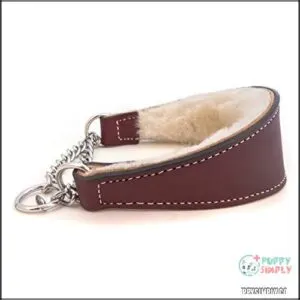
The Burgundy Sheepskin Leather Dog Collar blends elegance and comfort, making it a standout choice for your pet.
Crafted from durable bridle leather with a soft sheepskin lining, it’s gentle on your dog’s neck while reducing irritation.
The stainless steel hardware guarantees long-lasting use, even with active dogs, and with adjustable sizing from 10 to 26 inches, it provides a snug fit for breeds like Greyhounds or Dobermans.
Ideal for both training and daily walks, it’s as functional as it’s stylish.
Best For: Owners of slender-necked breeds like Greyhounds or Dobermans seeking an elegant, durable, and comfortable collar for daily use or training.
- Soft sheepskin lining prevents irritation and fur pulling.
- Durable bridle leather and stainless steel hardware ensure long-lasting use.
- Adjustable sizing makes it versatile for various breeds.
- Sheepskin lining may compact over time.
- Some users report concerns with chrome plating on the chain.
- Higher price point due to premium materials and craftsmanship.
6. Trainer Approved Martingale Dog Collar
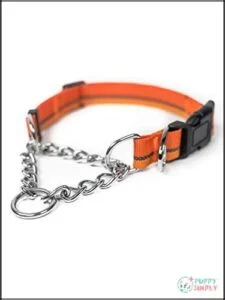
With a design that’s both practical and trainer-approved, the Trainer Approved Martingale Dog Collar offers gentle control for dogs who pull.
The stainless-steel chain and weather-proof nylon make it durable, while dual D-rings add versatility for training or regular walks.
It’s escape-proof, perfect for skittish pups, and guarantees safe, limited tightening to prevent choking.
While the buckle adds convenience, it has received mixed reviews regarding durability, but regular cleaning prevents fur staining, making it a reliable choice for most dog owners.
Best For: Dog owners looking for a durable, trainer-recommended collar that offers gentle control for dogs prone to pulling or escaping.
- Durable materials with weather-proof nylon and stainless-steel construction.
- Dual D-rings provide versatility for training and regular use.
- Limited tightening ensures safety and prevents choking.
- Mixed feedback on buckle durability with potential for breakage.
- Risk of fur staining on light-colored dogs without proper cleaning.
- Limited color options available for customization.
7. ComfortFlex Martingale Dog Collar
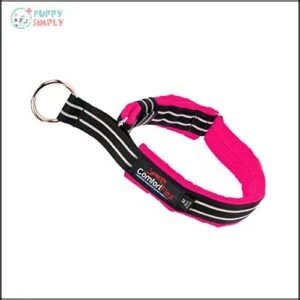
The ComfortFlex Martingale Dog Collar is thoughtfully designed for active dogs needing control and safety.
Its padded nylon guarantees comfort while guarding against irritation, even on long walks.
The collar is lightweight but strong, perfect for daily adventures or training sessions.
Sliding easily over your dog’s head, it eliminates buckle hassles, yet stays adjustable for a snug fit.
Reflective strapping adds visibility during evening strolls, keeping your pup safe.
While durable, avoid unsupervised use for maximum safety and product longevity.
Best For: Dogs with sensitive necks or those needing gentle control during daily walks or training.
- Comfortable padded nylon prevents skin irritation.
- Reflective webbing enhances safety in low light.
- Lightweight and easy to slip over the dog’s head.
- Metal slider rings may fail under stress for larger dogs.
- Padding is minimal and may not provide enough neck protection.
- Not suitable for unsupervised use or as a full-time collar.
8. Reflective Dog Collar with Quick Release Buckle
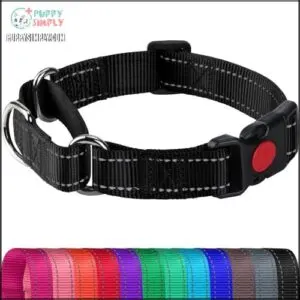
If you’re looking for a reliable and practical option, the Reflective Dog Collar with Quick Release Buckle is a solid choice.
Its built-in reflective material makes nighttime walks safer, and the quick-release buckle is perfect for easy use during emergencies.
The durable nylon construction guarantees comfort and longevity, even with regular wear, and it adjusts effortlessly to fit neck sizes from 10.5 to 25 inches, making it versatile for various breeds.
The Lightweight design means your dog stays comfy without sacrificing control, and the quick-release buckle is a notable feature for easy use.
Best For: Dog owners seeking a durable, reflective collar with a quick-release buckle for added safety and convenience during walks or emergencies.
- Plastic components may feel less sturdy compared to premium options.
- May not loosen easily after being pulled tightly.
- One user reported the collar coming apart during heavy use.
- Reflective material enhances visibility in low-light conditions.
- Adjustable fit accommodates various dog breeds and sizes.
- Lightweight and comfortable for daily use.
9. PetSafe Martingale Collar for Dogs
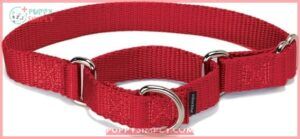
The PetSafe Martingale Collar blends safety and ease, perfect for daily walks.
Its durable nylon design holds up to wear and tear, while the quick-snap buckle makes life simpler when putting it on or off.
This collar tightens gently when your dog pulls, keeping them secure without choking, and loosens just as easily.
Available in multiple sizes and vibrant colors, it suits petite Chihuahuas to larger breeds like Labradors.
PetSafe’s trusted reputation guarantees quality, making training or everyday strolls stress-free.
Best For: Pet owners looking for a durable, comfortable, and secure collar for training or daily walks, suitable for all dog sizes.
- Durable nylon construction for longevity.
- Gentle tightening prevents slipping without choking.
- Easy-to-use quick-snap buckle for convenience.
- Limited color options for personalization.
- Nylon material may fray over extended use.
- Not ideal for dogs with extremely sensitive necks.
10. Dazzber Martingale Collar for Large Dogs
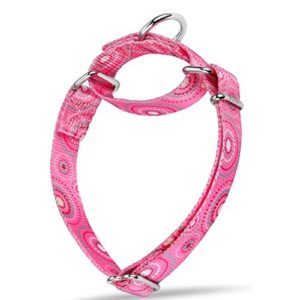
In the context of controlling large dogs, the Dazzber Martingale Collar offers both style and function.
Made from durable polyester fabric, it’s tough enough to handle strong pullers while maintaining soft comfort for your pup.
Its no-buckle design prevents escapes, making it perfect for dogs like Huskies or Corgis.
The collar adjusts easily, ensuring a snug yet safe fit, and with 16 colorful patterns to choose from, it’s a stylish pick that doesn’t compromise safety—ideal for walks, training, or everyday adventures!
Best For: Owners of large dogs who need a durable, escape-proof collar for training and everyday use.
- Durable and escape-proof no-buckle design.
- Stylish with 16 colorful patterns available.
- Comfortable polyester material suitable for strong pullers.
- Stiff material that may not soften over time.
- Requires precise adjustment for safety and effectiveness.
- Not recommended for unsupervised use.
11. Country Brook Pink Martingale Collar
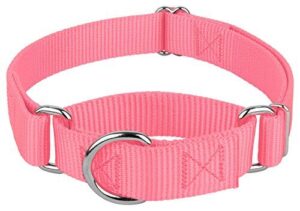
The Country Brook Pink Martingale Collar combines style with functionality, making it a favorite among dog owners.
Its vibrant pink design doesn’t just catch the eye—it’s built from 100% nylon webbing, guaranteeing durability and comfort.
Handcrafted in the USA, this collar features nickel-plated hardware for added strength.
Its adjustable fit (18-26 inches in this size) guarantees your dog stays secure without choking, and the limited-slip design prevents escapes.
Ideal for training or everyday use, the collar keeps your pup comfortable and safe.
Best For: Medium dog breeds, especially those in training or prone to slipping out of collars.
- Durable nylon construction with nickel-plated hardware.
- Adjustable fit ensures security without compromising comfort.
- Handcrafted in the USA for quality and longevity.
- Limited color options for those seeking variety.
- Not suitable for tie-out use.
- Reflective properties not included for nighttime safety.
12. Ruffwear Web Reaction Martingale Collar
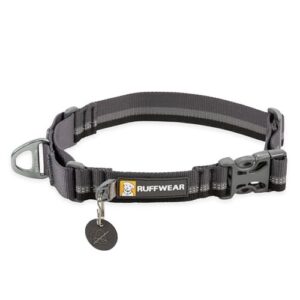
The Ruffwear Web Reaction Martingale Collar is perfect if your dog tends to slip out of regular collars.
Its limited-cinch design keeps walks secure and safe without choking. Reflective Tubelok webbing guarantees visibility, even during late-night strolls.
Lightweight yet durable, it stays comfortable while lasting through countless adventures. A silicone tag silencer adds peace to your outings by minimizing noise.
Whether your pup’s a sneaky escapist or just needs a sturdy solution, this collar has you covered beautifully.
Best For: Dogs that are prone to slipping out of traditional collars and require a secure, safe solution for everyday use.
- Limited-cinch design prevents escape without choking.
- Reflective Tubelok webbing enhances nighttime visibility.
- Lightweight and durable with long-lasting materials.
- Higher price compared to other collars.
- Limited color options available.
- Some users may prefer metal fasteners over the current design.
13. Max and Neo Purple Martingale Collar
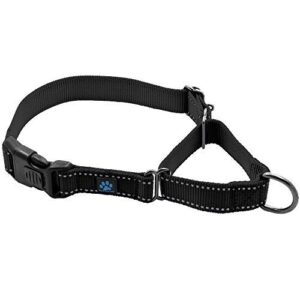
Max and Neo’s Purple Martingale Collar combines durability and heart.
Made of thick nylon with a sturdy stainless steel chain, it’s perfect for large dogs needing reliable control during walks.
Reflective stitching adds a safety boost, keeping night strolls worry-free.
The slip-over design simplifies use, while its donation program means every purchase helps rescue dogs in need.
Customers rave about its longevity and basic cleaning convenience. However, double-check sizing—some users recommend upsizing for the best fit.
Quality meets compassion here!
Best For: Owners of medium to large dogs who value safety, durability, and supporting animal rescues.
- Durable nylon and stainless steel construction.
- Reflective stitching for nighttime visibility.
- Supports dog rescues with every purchase.
- Sizing may run small; upsizing might be necessary.
- Lacks a clasp, which may not suit all preferences.
- Higher price point compared to similar collars.
Martingale Collar Safety Tips
Keeping your dog safe with a martingale collar starts with proper use and careful supervision.
By following a few simple tips, you can guarantee this tool is effective, comfortable, and secure for your furry friend.
Proper Fit Guidelines
A proper fit guarantees safety and comfort with martingale collars.
Follow these steps:
- Measure snugly behind your dog’s ears; note neck size.
- Use the Two-Finger Rule to check fit – not tight, not loose.
- Consider breed-specific neck shapes.
- Conduct regular collar fit testing and visual checks.
- Adjust frequently as your dog grows or weight shifts, ensuring a proper fit at all times.
Adjusting The Collar
Adjusting martingale collars is simple with the right steps. Always test collar fit using the two-finger rule—snug but not too tight.
Consider breed differences, as narrow-headed dogs might need extra attention. Growth considerations mean readjusting frequency varies by age.
Follow collar sizing guidelines, and revisit collar adjustment regularly. Proper tightness guarantees comfort and prevents slipping during walks, promoting safe collar usage instructions effectively, ensuring comfort.
Safety Tips for Use
Using a martingale collar safely means always supervising your dog.
Unattended risks, like snagging, make it critical to remove the collar during play or crate time. For puppies or bull-neck breeds, consider alternatives.
Inspect collars for wear, and avoid using them for tie-outs. Material considerations matter too—ensure comfort and durability for escape-proof training and dog safety.
These collars offer even pressure distribution, making them safer than choke chains.
Avoiding The Wrong Martingale Collar
Choosing martingale collars isn’t one-size-fits-all.
Pay attention to material sensitivity, as some dogs prefer soft fabrics over chain loops. Match collar sizes to your dog’s breed specifics and activity level—narrow heads and active temperaments need extra-secure fits.
Ethical sourcing matters too; well-made collars last longer and feel safer. Measure carefully to avoid choking risks or escaping Houdinis! Consider the overall quality and durability of the collar.
Martingale Collar Benefits
Martingale collars offer a safe, effective way to keep your dog secure while preventing them from slipping out of their collar.
With their gentle tightening design, they provide control without causing discomfort or choking.
Prevention of Escape
Martingale collars work wonders for escape prevention, especially with skittish dogs or narrow head breeds like sighthounds.
These noslip collars gently tighten, making them escape-proof collars that keep your pup secure during leash training.
If your dog’s an expert at Collar Slippage, martingale collars act as a reliable backup system.
- Comfortable for narrow-headed dogs
- Prevents backing out of collars
- Ideal for leash training
Even Pressure Distribution
Martingale collars distribute pressure evenly around your dog’s neck, reducing the risk of injury.
This humane design guarantees comfortable control without choking, making it a great choke alternative for sensitive pups.
The even pressure distribution prevents discomfort and protects your dog’s neck during walks.
For dogs that are escape artists, consider how martingale collars prevent slipping, it’s a smart choice for injury prevention, offering control with a focus on safety and comfort.
Control Without Choking
Martingale collars offer control without choking, making them a humane alternative to harsh dog collars.
Their gentle correction guarantees safe tightening, giving you comfortable control during walks.
Designed for injury prevention, they distribute pressure evenly, avoiding harm to your dog’s neck.
These collars make humane training easy while keeping your pup secure and happy—no slipping, no stressing!
Adjustable Fit
An adjustable fit makes martingale collars great for all dogs, whether they’re sprouting puppies or seasoned pros.
Proper collar sizing factors in breed differences, seasonal adjustments like heavier coats, and your dog’s activity level.
Adjustable dog collars let you tweak for growth considerations or layering clothes, and accurate collar measurement guarantees safety and comfort without compromise.
It’s versatility that keeps tails wagging!
Training Tool
In the context of humane training, martingale collars shine as a tool for leash training and gentle guidance.
They help with skill development through positive reinforcement and consistent behavior correction.
Dogs learn leash manners calmly and safely, building trust.
- Encourages relaxed leash walks
- Promotes positive reinforcement and humane control
- Helps prevent escape during training
- Boosts confidence in dog training routines
Frequently Asked Questions (FAQs)
Do vets recommend martingale collars?
Yes, many vets recommend martingale collars for dogs prone to slipping out of traditional collars.
They’re safe, effective, and humane when used properly, offering control without choking.
Always supervise and verify the right fit.
Are martingale collars good for training dogs?
Think of it like a steady hand on a steering wheel—martingale collars gently guide and teach leash manners.
They’re great for discouraging pulling or escaping, offering your dog safety and you control during training.
Is it OK for a dog to wear a martingale collar all the time?
It’s not ideal to let your dog wear a martingale collar all the time.
While great for walks, the tightening loop can catch on objects indoors, posing a safety risk.
Stick to supervised use.
What does a martingale collar do?
A martingale collar gently tightens when your dog pulls, keeping them secure without choking.
It’s perfect for skittish pups or escape artists, offering control and safety during walks.
While staying loose and comfy when relaxed, providing the necessary comfort for your dog.
Do martingale collars stop pulling?
Pulling isn’t a one-way ticket when using a martingale collar.
Its gentle tightening discourages pulling by applying light pressure, giving you better control.
It’s effective for training but won’t fully stop strong pullers without consistent practice.
Are martingale collars ethical?
They’re considered ethical because they gently prevent escape without choking.
Unlike choke collars, they tighten only to a safe limit.
When properly fitted and supervised, they offer humane control for leash training and skittish dogs.
Are martingale collars suitable for puppies?
Puppies can use these collars if monitored closely, but it’s important to fit them properly to avoid choking risks.
They’re better suited for training older pups who’ve outgrown their enthusiastic, tugging-at-everything stage, and are thus less likely to cause accidents.
Is it safe to leave a martingale collar on my dog when unsupervised?
Better safe than sorry—remove the collar when unsupervised.
Martingale collars can catch on objects, posing a choking risk.
They’re great for walks, but indoors or during playtime, switching to a breakaway option guarantees safety.
How often should I check the fit of my dog’s martingale collar?
You should check your dog’s martingale collar fit weekly or anytime their weight changes.
Make sure it’s snug but loose enough for two fingers to fit underneath.
A proper fit guarantees safety and comfort.
When should I transition my dog to a martingale collar?
When your dog turns into an escape artist or starts pulling like they’re auditioning for a sled team, it’s martingale time.
Switch during walks to prevent slipping out while keeping control and comfort intact.
Conclusion
Choosing the right martingale collar is like finding the perfect pair of shoes—it needs to fit well, be comfortable, and serve its purpose.
With their gentle control and anti-escape design, martingale collars are a reliable choice for training, daily walks, and style.
Whether your dog’s a master escape artist or just needs a bit more guidance, a quality martingale collar guarantees safety without sacrificing comfort.
Explore options, and you’ll find one that’s perfect for your pup, providing comfort and assurance for both you and your dog!
- https://pethealthguru.com/about/
- https://blog.theartfulcanine.com/martingale-dog-collars/
- https://www.printablerulers.net/
- https://drydogs.co.uk/blogs/news/ultimate-guide-to-martingale-collars-for-dogs
- https://furevergreys.com/blogs/snoot-scoop/are-martingale-dog-collars-safe?srsltid=AfmBOopFpzZyb-emvmZpBAgzW_9hTwPQdHQZkYLuhGRAdjCVhyqGAqk5

